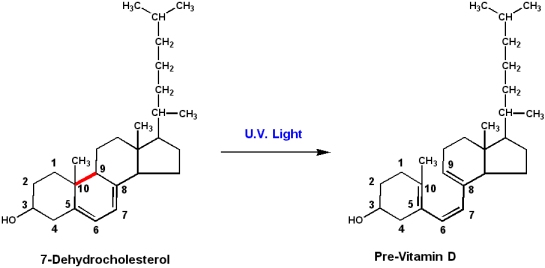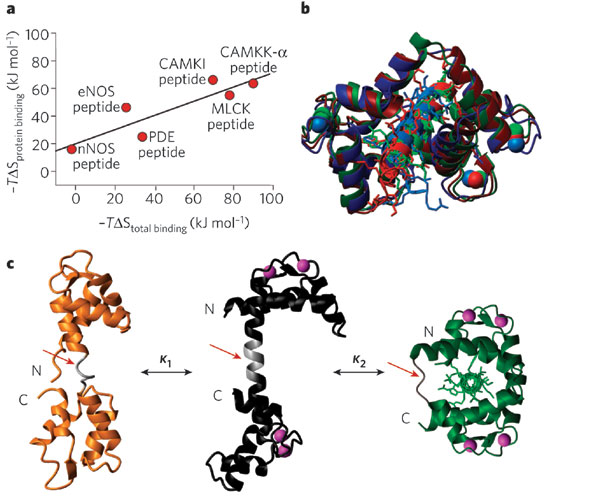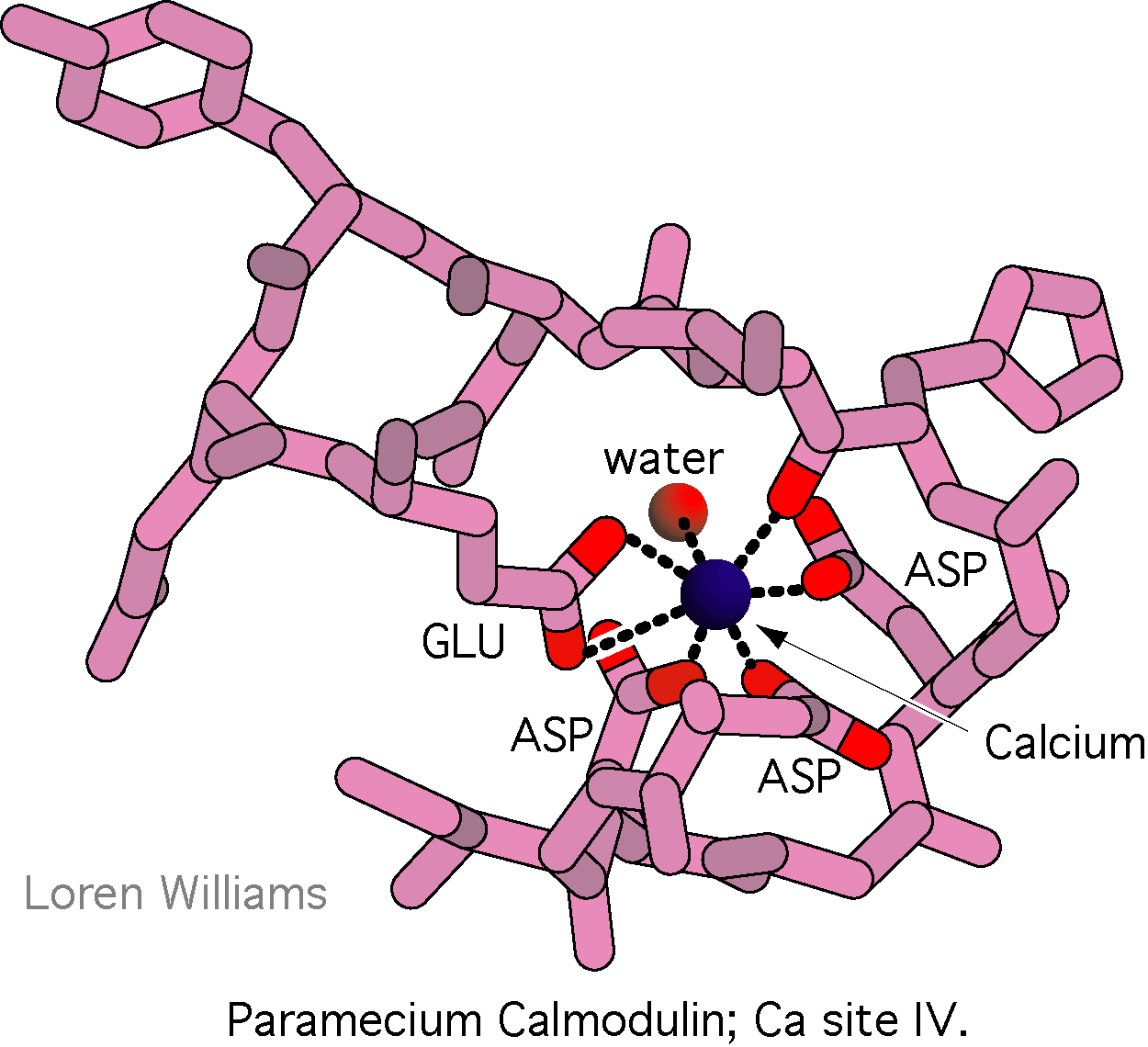| Hint | Food | 맛과향 | Diet | Health | 불량지식 | 자연과학 | My Book | 유튜브 | Frims | 원 료 | 제 품 | Update | Site |
|
원료 ≫ 비타민 ≫ 비타민 D 비타민 D Cholecalciferol 비타민 D - 콜레스테롤의 합성과정 - 비타민 D 합성: 햇빛으로 만들어진다? - 비타민 D 작용, 기능 - 비타민 D 부작용? 비타민 D는 엄밀히 말하면 체내에서 생성되므로 비타민이 아니고 콜레스테롤계 호르몬이다  칼시페롤이라고도 부르는 비타민 D는 지용성 비타민. 비타민 D는 음식에 들어있지만 햇빛에 들어있는 자외선을 쏘이면 7-dehydrocholesterol로 부터 사람의 피부에서도 만들어진다. (Light energy induces bond-breakage (between carbons 9 and 10) and formation of previtamin D3 : 따라서 엄밀히 말하면 비타민이라 할 수 없다) 비타민 D는 다양한 형태가 있는데 각각은 활성이 서로 다르다. 어떤 형태는 몸에서 활성이 비교적 없어 비타민으로 작용하기에는 능력이 제한되어 있다. 간과 콩팥은 비타민 D가 활성이 있는 호르몬 형태로 바뀌도록 도와준다. Cholecalciferol is really a prohormone. Derivatives of this compound regulate calcium and phosphate metabolism. Inadequate intestinal absorption of calcium and phosphate can result in demineralization of bones, and the disease Rickets 비타민 D의 주된 생물학적 작용은 피속의 칼슘과 인의 농도를 정상으로 유지하는 것이다. 비타민 D는 점막세포에서 칼슘 흡수에 필요한 단백질을 합성하고 세포막의 유동성을 증가시켜 칼슘과 인이 쉽게 세포막을 통과할 수 있게 한다. 비타민 D는 칼슘의 흡수를 도와, 뼈를 튼튼하게 만들어 유지하는데 도움이 된다. 비타민 D는 다른 여러 비타민, 무기물, 호르몬과 함께 작용하여 뼈에 칼슘과 다른 무기물이 침착되는 것을 촉진한다. 비타민 D가 없으면 뼈는 얇고, 부러지기 쉽고, 연약하거나, 변형될 수 있다. 비타민 D는 뼈가 약해지는 결함으로 인해 생기는 골격의 병인 어린이의 구루병과 어른의 뼈연화증을 예방한다.  Calmodulin (CaM) (an abbreviation for CALcium-MODULated proteIN) is a calcium-binding messenger protein expressed in all eukaryotic cells. CaM is a multifunctional intermediate messenger protein that transduces calcium signals by binding calcium ions and then modifying its interactions with various target proteins.     Harvard Men's Health Watch Vitamin D and your health: Breaking old rules, raising new hopes Published: February, 2007 Vitamin D was discovered in 1920, culminating the long search for a way to cure rickets, a painful childhood bone disease. Within a decade, the fortification of foods with vitamin D was under way, and rickets became rare in the United States. But solving the problem of rickets was only the beginning of research into vitamin D. Results suggest that vitamin D may have an important role in many aspects of human health, from bone fractures to prostate cancer, cardiovascular disease, neuromuscular problems, and diabetes. Breaking the old rules Vitamin D is one of the 13 vitamins discovered in the early 20th century by doctors studying nutritional deficiency diseases. Ever since, scientists have defined vitamins as organic (carbon-containing) chemicals that must be obtained from dietary sources because they are not produced by the body's tissues. Vitamins play a crucial role in our body's metabolism, but only tiny amounts are needed to fill that role. Although vitamin D is firmly enshrined as one of the four fat-soluble vitamins, it is not technically a vitamin. True, it's essential for health, and only minuscule amounts are required. But it breaks the other rules for vitamins because it's produced in the human body, it's absent from all natural foods except fish and egg yolks, and even when it's obtained from foods, it must be transformed by the body before it can do any good. As our habits change, most of us cannot rely on our bodies to produce vitamin D the old-fashioned way. Instead, we increasingly depend on artificially fortified foods and pills to provide this vital nutrient. Coming full circle in the modern world, this substance may actually come to fit the technical definition of a vitamin. What is vitamin D? Vitamin D is not one chemical but many. The natural type is produced in the skin from a universally present form of cholesterol, 7-dehydrocholesterol. Sunlight is the key: Its ultraviolet B (UVB) energy converts the precursor to vitamin D3. In contrast, most dietary supplements are manufactured by exposing a plant sterol to ultraviolet energy, thus producing vitamin D2. Because their function is almost identical, D2 and D3 are lumped together under the name vitamin D "" but neither will function until the body works its magic (see figure). How your body makes vitamin D The sun's energy turns a chemical in your skin into vitamin D3, which is carried to your liver and then your kidneys to transform it to active vitamin D. The first stop is in the liver, where vitamin D picks up extra oxygen and hydrogen molecules to become 25-hydroxyvitamin D, or 25(OH)D. This is the chemical that doctors should measure to diagnose vitamin D deficiencies. But although 25(OH)D is used for diagnosis, it can't function until it travels to the kidney. There it acquires a final pair of oxygen and hydrogen molecules to become 1,25 dihydroxyvitamin D; scientists know this active form of the vitamin as 1,25(OH)2D, or calcitriol, but for ordinary folks the name vitamin D is accurate enough. How it works Vitamin D's best-known role is to keep bones healthy by increasing the intestinal absorption of calcium. Without enough vitamin D, the body can only absorb 10% to 15% of dietary calcium, but 30% to 40% absorption is the rule when vitamin reserves are normal. A lack of vitamin D in children causes rickets; in adults, it causes osteomalacia. Both bone diseases are now rare in the United States, but another is on the rise "" osteoporosis, the "thin bone" disease that leads to fractures and spinal deformities. Low levels of vitamin D lead to low bone calcium stores, increasing the risk of fractures. If vitamin D did nothing more than protect bones, it would still be essential. But researchers have begun to accumulate evidence that it may do much more. In fact, many of the body's tissues contain vitamin D receptors, proteins that bind to vitamin D. In the intestines, the receptors capture vitamin D, enabling efficient calcium absorption. But similar receptors are also present in many other organs, from the prostate to the heart, blood vessels, muscles, and endocrine glands. And work in progress suggests that good things happen when vitamin D binds to these receptors. The main requirement is to have enough vitamin D "" but many Americans don't. Vitamin D deficiencies Vitamin D deficiencies were rare when most men rolled up their sleeves to work in sunny fields. But as work shifted from farms to offices, that changed. Because pigmentation can reduce vitamin D production in the skin by over 90%, nonwhite populations are at particular risk. Deficiencies are also common in patients with intestinal disorders that limit absorption of fat and those with kidney or liver diseases that reduce the conversion of vitamin D to its active form, calcitriol (1,25(OH)2D). In addition, certain medications reduce the availability or activity of vitamin D. And even in healthy people, advancing age is linked to an increased risk of vitamin D deficiency. A number of factors can play a role. Limited exposure to sunlight heads the list. Except during the short summer months, people who live at latitudes above 37 degrees north or below 37 degrees south of the equator don't get enough UVB energy from the sun to make all the vitamin D they need. The same is true for people who spend most of their time indoors and for those of us who avoid sunshine and use sunscreens to protect our skin from the harmful effects of ultraviolet radiation (see box below). It's an example of an unforeseen consequence of wise behavior, but you can enjoy sun protection and strong bones, too, by taking vitamin supplements. Sunscreens Like politicians, doctors often have to compromise; when it comes to sunshine, most pols promise blue skies, while most docs turn out to be the shady guys "" or, at least, sunscreen advocates. Sunlight contains two forms of radiant energy, ultraviolet A (UVA) and ultraviolet B (UVB). UVB provides the energy your skin needs to make vitamin D, but that energy can burn the skin and increase the cell damage that leads to cancer. UVA also contributes to skin damage and premature aging. To protect yourself, avoid the summer sunshine, especially between 10 a.m. and 2 p.m. Whenever possible, wear a large-brimmed hat and a tightly woven, dark-colored long-sleeve shirt and long pants when you go out in the sun. But summer garb is usually lightweight and exposes a lot of skin. That's where a sunscreen comes in. Look for a product with an SPF of at least 15; fair-skinned people would be wise to shoot for 30 or higher. But since SPFs apply only to UVB, look for a "broad spectrum" sunscreen that also protects against UVA; most contain titanium dioxide, zinc oxide, or avobenzone (also known as Parsol 1789). Above all, apply your sunscreen early, often, and liberally. These many factors explain why vitamin D deficiencies are shockingly common in the United States. Although standards vary, most experts agree that levels of 25(OH)D below 20 ng/ml (nanograms per milliliter) reflect clear-cut vitamin D inadequacy, while levels between 20 and 30 ng/ml are borderline. Using similar criteria, American researchers have reported deficiencies in 42% of African American women aged 15 to 49, in 41% of non-hospitalized patients aged 49 to 83, and in up to 57% of hospitalized patients. And low levels of vitamin D are common even in apparently healthy young adults; in one study, more than a third of people between the ages of 18 and 29 were deficient. Numbers can never tell the whole story, but in this case, "D-ficiencies" add up to a wide range of health concerns. Osteoporosis and fractures It's a paradox: Skeletal health is the best-known contribution of vitamin D, but it has also become the most controversial. Although doctors agree that vitamin D deficiency increases the risk of osteoporosis and fractures, they disagree about the benefits and optimal dosage of supplements. Without enough vitamin D, the intestines cannot efficiently absorb calcium. But because blood calcium is critical for neuromuscular and cardiac function, the body does not allow levels to fall. Instead, it pours out parathyroid hormone, which mobilizes calcium from bone. Blood calcium levels remain normal, so your heart and nerves keep working nicely. But your bones bear the brunt: As bone calcium density falls, bones become weak and fracture-prone. Most studies show that a lack of vitamin D increases the risk of osteoporosis and the likelihood of hip and other nonspinal fractures. But there is considerable disagreement about how much supplements reduce the risk of fractures. Some studies include only women, others both men and women; some include only frail, elderly, or institutionalized subjects, others physically active people; some use vitamin D alone, others a combination of D and varying doses of calcium; and some administer 400 international units (IU) of vitamin D a day, others up to 800 IU a day. Despite this great variability, a major 2005 meta-analysis of 12 randomized clinical trials concluded that daily vitamin D supplements of 700""800 IU could reduce the risk of hip fractures by 26% and of other nonspinal fractures by 23%. In contrast, supplements of 400 IU a day, the conventional dose, had no benefit. Most authorities agree that high doses of vitamin D supplements appear to protect against fractures and low doses do not. But two trials that found no benefit from 800 IU a day were completed after the 2005 meta-analysis, ensuring that the proper dose will remain a bone of contention. Prostate cancer Some men mistakenly dismiss osteoporosis as a women's worry, but none fail to recognize the importance of prostate cancer. Vitamin D has an important role in regulating cell growth. Laboratory experiments suggest that it helps prevent the unrestrained cell multiplication that characterizes cancer by reducing cell division, restricting tumor blood supply (angiogenesis), increasing the death of cancer cells (apoptosis), and limiting the spread of cancer cells (metastasis). Like many human tissues, the prostate has an abundant supply of vitamin D receptors. And, like some other tissues, it also contains enzymes that convert biologically inactive 25(OH)D into the active form of the vitamin, 1,25(OH)2D. These enzymes are much more active in normal prostate cells than in prostate cancer cells. Do the results from these experiments translate into clinically important effects? Possibly. Several lines of evidence are relevant. First, the calcium connection. In 1998, Harvard's Health Professionals Follow-up Study of 47,781 men reported that a high consumption of calcium, either from food or supplements, was associated with an increased risk of advanced prostate cancer; the risk was greatest in men taking more than 2,000 mg of calcium a day. Since then, other studies have confirmed a link between very high levels of dietary calcium and increased risk, but they have exonerated modest calcium consumption. The Harvard scientists speculate that the problem is not calcium itself but a relative lack of active vitamin D. That's because high levels of calcium can reduce the body's production of the active form of the vitamin. Second, the sunlight connection. Prostate cancer is more common in North America and northern Europe than in the sunnier climates of Asia, Central America, or Africa. In the United States, the disease is more prevalent in African Americans than Caucasian Americans. Of course, sunlight is just one of the many differences between these groups of men, and various genetic, dietary, lifestyle, and health care disparities could account for the prostate cancer gap. Indeed, early studies failed to demonstrate a clear association between blood levels of 25(OH)D and prostate cancer. But in 2005, a 13-year Harvard study of 2,399 men reported that those with high blood levels of both forms of vitamin D "" 25(OH)D and 1,25(OH)2D "" enjoyed a 45% lower risk of developing aggressive prostate cancer than those with below-average levels. And certain genetic variations in the vitamin D receptor appeared to enhance the protective effect of the vitamin. Can vitamin D reduce your risk of prostate cancer? It's too early to say "" but it's a possibility that requires additional study. Other malignancies The risk of colon cancer, breast cancer, and other malignancies appears to rise in populations at latitudes far from the equator. Sun exposure and vitamin D levels may be part of the explanation. As in the case of prostate cancer, the details vary from study to study. Still, a 2006 review concluded that the overall pattern suggests benefit, especially for colon cancer. A 2006 Harvard study of men calculated that a 10 ng/ml increase in blood levels of 25(OH)D might be linked to a 17% reduction in the risk of developing cancer and a 29% lower chance of dying from the disease. And even more recent research suggests that vitamin D may have a role in reducing the risk of cancer of the pancreas and kidney. It's more reason to be hopeful about vitamin D "" and more reason to call for additional research. Observational studies and sophisticated calculations are important, but they can be overturned by the results of randomized clinical trials. Indeed, in 2006 a major seven-year trial of 400 IU of vitamin D and 1,000 mg of calcium a day found no protection against colon cancer in women. Dashed hopes for beta carotene and vitamin E also remind us that caution and patience are the watchwords for supplements "" and the conflicting results from randomized trials examining the relationship between vitamin D and fractures remind us that even clinical trials can pose therapeutic "D-lemmas." Other diseases Vitamin D may also have potential benefits in conditions other than osteoporosis and cancer; although they remain speculative, they deserve a look. Neuromuscular function. Osteoporosis increases the risk of fractures. Falling also breaks bones, and vitamin D can help with both brittle bones and falls. A 2004 meta-analysis of five randomized clinical trials concluded that vitamin D supplements reduce the risk of falling by 22%; most of the participants were women. A 2006 study reported that a daily dose of 700 IU produced a 46% reduction in falls in women but no protection for men. The benefit was greatest in older, less active women; the possible gender difference may be explained by differences in physical activity, muscle size, or diet. Since vitamin D binds to receptors in muscles, the improvements in strength and balance may account for the benefit. Vitamin D deficiency has been linked to persistent and otherwise unexplained muscle and bone pain, and some patients have been helped by supplements. Several observational studies have linked a high consumption of vitamin D with a reduced risk of multiple sclerosis. Cardiovascular disease. Vitamin D may play an important role in vascular health. Osteoporosis is associated with an increased risk of coronary artery disease, and low blood levels of vitamin D have been linked to increased coronary artery calcification. Although animal studies suggest that vitamin D has a role in regulating blood pressure, a 2005 Harvard analysis found no link between the consumption of vitamin D and human hypertension. Still, low levels of the vitamin appear related to an increased risk of stroke and congestive heart failure; and a study found that supplements reduce inflammation in patients with congestive heart failure. Other disorders. Although experiments show that vitamin D can protect animals from diabetes, human studies are less convincing. A study of 83,779 women did not find an overall protective role, but it did suggest that high doses of vitamin D (more than 800 IU a day) and calcium (more than 1,200 mg a day) might reduce the risk of type 2 diabetes by 33%. Using data from the Framingham Heart Study, researchers found that high levels of vitamin D were associated with a reduced risk of arthritis of the knee. High levels have also been linked to better lung function, a stronger immune system, and an enhanced ability to fight off certain infections, such as tuberculosis. All these potential benefits require additional study, but vitamin D ointments have already been approved to treat psoriasis. "D" right amount Until 1997, the recommended dietary allowance (RDA) for vitamin D was 200 IU for all adults. Faced with growing evidence of vitamin D deficiencies in Americans, the RDA for 51- to 70-year-olds was increased to 400 IU, and to 600 IU for people older than 70. Is more better? New research suggests that it is, and many authorities are recommending 800 or even 1,000 IU a day. Remember, though, that you can get too much of a good thing. Like the other fat-soluble vitamins, vitamin D is stored in the body's adipose (fat) tissue. That means your body can mobilize its own reserves if your daily intake falters temporarily "" but it also means that excessive doses of vitamin D can build up to toxic levels. At those extremes, vitamin D can raise blood calcium to levels that can cause grogginess, constipation, and even death. But it takes massive overdosing to produce toxicity, and doses up to 2,000 IU a day are considered safe. Delivering D You can make your vitamin D the old-fashioned way, by exposing your skin to UVB radiation in sunlight. It doesn't take much, but people living north of the 37-degree-latitude line "" roughly the imaginary line between Philadelphia and San Francisco "" can't get enough UVB in winter to do the trick. And many others will find it all too easy to overdose on UVB, increasing their risk of malignant melanomas and other skin cancers, as well as wrinkles and premature skin aging. All in all, most doctors recommend avoiding sunlight (see box) and getting vitamin D by mouth. Diet can help, but it's very hard to approach the new goals with food alone. Fish and shellfish provide natural vitamin D (oily fish are best), but you'll have to eat about 5 ounces of salmon, 7 ounces of halibut, 30 ounces of cod, or nearly two 8-ounce cans of tuna to get just 400 IU. An egg yolk will provide about 20 IU, but since it also contains nearly a day's quota of cholesterol, you can't very well use eggs to fill your tank with D. Other foods have even less D, which is why manufacturers fortify milk, some yogurt, some orange juice, and many cereals with vitamin D. In general, a serving will provide about 100 IU; that means drinking a quart of fortified milk to get 400 IU. Most people require supplements to get the vitamin D they need. It's the main benefit of a daily multivitamin; most provide 400 IU. Remember to read the labels carefully so you won't get too little or too much. And although cod liver oil is rich in vitamin D, it has too much vitamin A for regular use. New light on the sunshine vitamin It used to be simple: just get a "healthy" tan and your body will make all the vitamin D it needs. Desk jobs and sunscreen have changed all that, just as research is underlining the importance of vitamin D and suggesting its possible role in preventing many health problems. That makes vitamin D a dilemma of modern life that has a modern solution: eating fish and drinking some low-fat fortified milk, along with judicious doses of vitamin D supplements. |
||||
|
|
|||